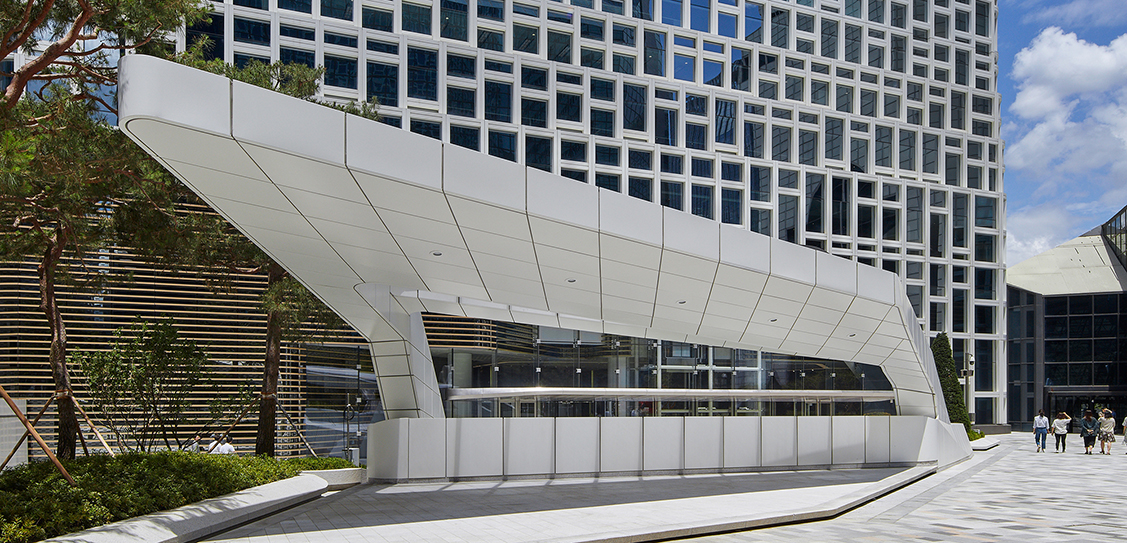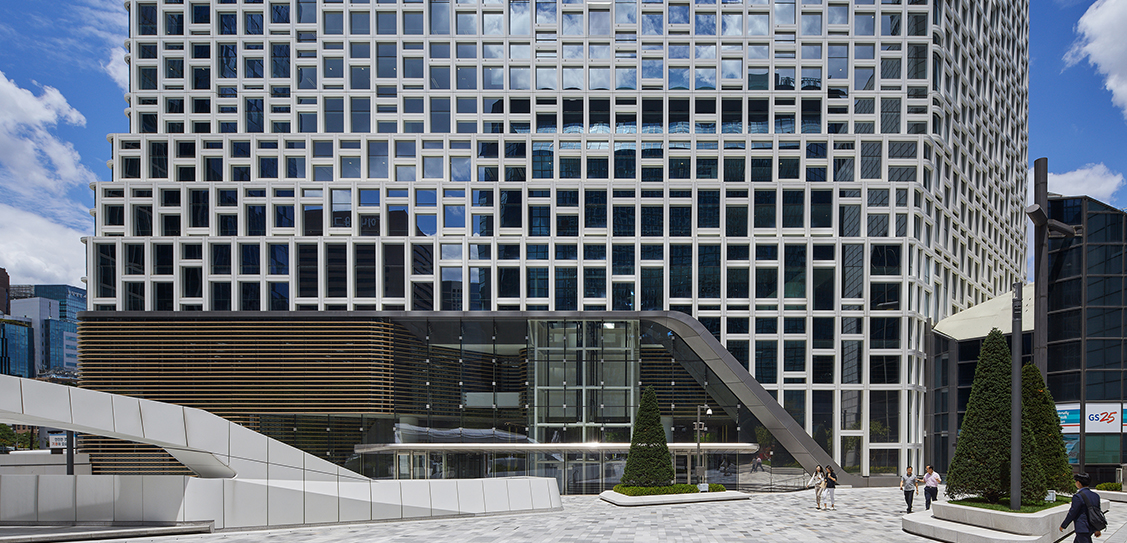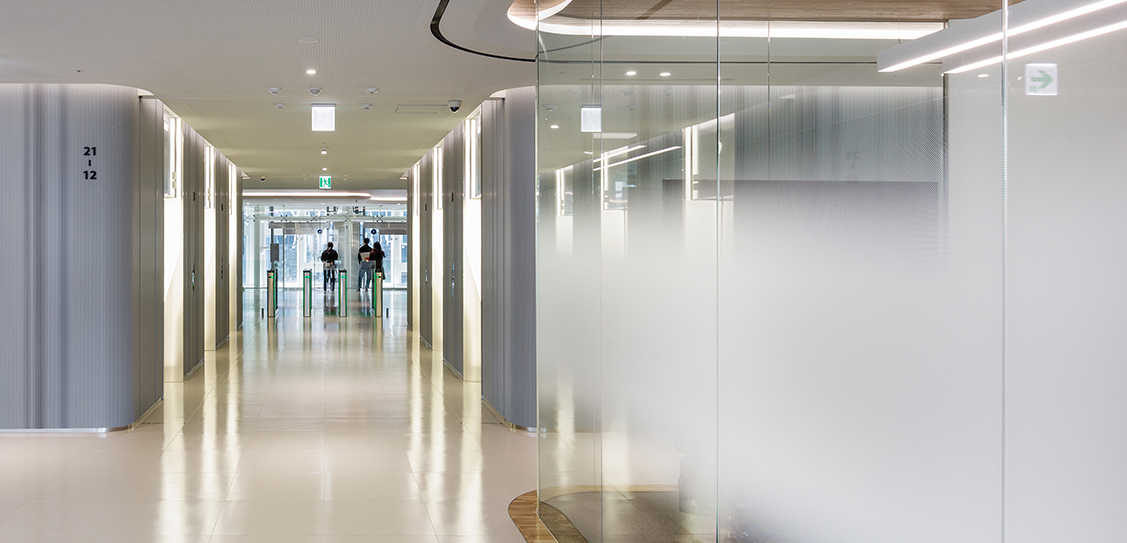UNStudio’s remodelling of the Hanwha headquarters building in Seoul has been completed.
With this retrofit, the headquarters of one of the world's market leaders in solar panels has been modernised to meet the most up to date sustainability requirements.
Based on environmental considerations, a conscious decision was made to remodel the existing building, rather than for demolition and new build.
By way of an efficient construction method, UNStudio and Hanwha were also able to ensure that the employees could continue to work in the building throughout the renovation.
The result of this ‘remodelling in place' is a building with a healthy indoor climate, an extremely flexible programme and a completely new, energy-generating facade with integrated solar panels.
The building now also effectively expresses the identity and ambitions of the Hanwha Group.
The retrofit of the office tower incorporates the remodelling of the facade, the interior of the common spaces, lobbies, meeting levels, auditorium and executive areas, along with the redesign of the landscaping.
Located on the Cheonggyecheon in Seoul, the 57,696 square metre headquarter building was seen to no longer reflect Hanwha as one of the leading environmental technology providers in the world.
For the competition to remodel the tower, UNStudio teamed with Arup (sustainability and facade consultant) and Loos van Vliet (landscape designer).
Following the selection of the competition design, agLicht joined as lighting consultant.
The existing facade consisted of horizontal bands of opaque panelling and single layers of dark glass.
In the remodelling, this is replaced by clear insulated glass and aluminium framing.
Remodelling
The retrofit of the facade and the interiors was carried out while the building remained fully occupied and functional, thus enabling the company to remain working in the building throughout the construction period.
In order to enable this, three floors were refurbished at a time, in both the interior and on the facade.
Electing to choose a construction method that would have minimal impact on both the operation of the company and on the environment, serves as a good example for all stakeholders in the construction process to consider alternative parameters and sustainable measures that can be introduced when retrofitting existing buildings.
The basis for the facade expression is to achieve an effect of variety, irregularity and intricacy throughout.
This expression is informed by the sun and orientation factors, as well as the programme: by varying the placement of the facade panels a variety of programme-related openings are created.
Responsive facade
Addressing the request that the design is guided by the surroundings, influenced by nature and driven by the environment, UNStudio developed an integrated responsive facade concept which improves the indoor climate of the existing building and reacts to both the programme distribution and the location.
By means of a reductive, integrated gesture, the facade design for the Hanwha HQ implements fully inclusive systems which significantly impact the interior climate of the building, improve user comfort and ensure high levels of sustainability and affordability.
Through fully integrated design strategies today’s facades can provide responsive and performative envelopes that both contextually and conceptually react to their local surroundings, whilst simultaneously determining interior conditions.
Ben van BerkelIn the design for the Hanwha headquarter building the north facade opens to enable daylighting within the building but becomes more opaque on the south facade, where the sun would otherwise have too much impact on the heat load of the building.
Openings within the facade are further related to the views: opening up where views are possible, but becoming more compact on the side adjacent to the nearby buildings.
PV integration and solar impact
Direct solar impact on the building is reduced by shading which is provided by angling the glazing away from direct sunlight, while the upper portion of the south facade is angled to receive direct sunlight. PV cells are placed on the opaque panels on the south/southeast facade at the open zones where there is an optimal amount of direct sunlight.
Furthermore, PV panels are angled in the areas of the facade where energy from the sun can best be harvested.
In terms of landscape design, the fluid design of the plaza landscape encourages people to enter from all sides, while the multifunctional planters not only serve as a wayfinding element but also provide customised seating areas.
Main lobbies, lift lobbies, office levels and meeting levels
In UNStudio’s concept for the lobby of the Hanwha headquarters building the landscape continues into the interior and acts as a guiding aid, while natural materials and planting provide a relaxing environment for visitors.
A subtle colour scheme is combined with wooden furnishing and, in both the north and the south entrance lobbies, a coffee corner creates the possibility for social interaction and exchange.
The increased floor to ceiling height of the lobbies is emphasised through the new facade design by increasing the daylight entering the lobby areas and creating visual connections between the outside plazas and both lobbies.
At the lift lobbies, intuitive guidance through interior design elements and integrated lighting seamlessly connect the common areas and hallways at all office levels.
This linkage between lift lobbies and the common reception areas and hallways creates a common identity at the different levels, yet enables flexibility in the workspaces and the allocation of different type/sizes of offices, both now and for the future.
The wayfinding strategy continues through to the meeting rooms, creating spaces enclosed by glass, with different degrees of transparency to create enough privacy but also create enough translucency to guarantee well-lit meeting spaces.
Among the different types of meeting spaces is the multi-purpose auditorium, which can be set up in different arrangements in accordance with the event type or meeting.
The wall cladding in the auditorium is designed to ensure good acoustics, while animated lighting and different settings enable the atmosphere to be adjusted as required for different events.
Restaurant and executive levels
The collective spaces serve all the employees of Hanwha, bringing together the different departments and providing informal spaces for social gathering with high spatial and material qualities.
The 28th floor restaurant is a space of rest, relaxation and nourishment.
Warm wood tones, natural materials and green planting create spaces where the employees of the headquarter building can come to recharge and rejuvenate.
The restaurant is divided into multiple zones each catering to different types of cuisines and dining.
Colour accents found in the textiles and furniture differentiate the multiple zones and give it an individual character.
The private dining has a more intimate feel with a darker wood colour palette and intricate lighting details.
The different boardrooms at the executive level (level 27) have also undergone a full renovation.
The interior design mixes zones for meeting activities that are more formal, with more social and informal meeting areas.
On the executive level, the interior concept combines the guiding principles of wayfinding through lighting and creates within a large corporate office floor, several private and custom-designed zones that offer various possibilities for working and meeting in different constellations, from small meetings to focused work, to large boardroom gatherings.



